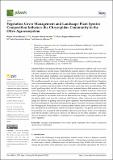Por favor, use este identificador para citar o enlazar a este item:
http://hdl.handle.net/10261/305897COMPARTIR / EXPORTAR:
 SHARE SHARE
 CORE
BASE CORE
BASE
|
|
| Visualizar otros formatos: MARC | Dublin Core | RDF | ORE | MODS | METS | DIDL | DATACITE | |

| Campo DC | Valor | Lengua/Idioma |
|---|---|---|
| dc.contributor.author | Alcalá Herrera, Rafael | es_ES |
| dc.contributor.author | García Fuentes, A. | es_ES |
| dc.contributor.author | Ramos Font, María Eugenia | es_ES |
| dc.contributor.author | Fernández-Sierra, María Luisa | es_ES |
| dc.contributor.author | Ruano Díaz, Francisca | es_ES |
| dc.date.accessioned | 2023-04-11T12:40:04Z | - |
| dc.date.available | 2023-04-11T12:40:04Z | - |
| dc.date.issued | 2022 | - |
| dc.identifier | doi: 10.3390/plants11233255 | - |
| dc.identifier | issn: 2223-7747 | - |
| dc.identifier.citation | Plants 11: 3255 (2022) | es_ES |
| dc.identifier.uri | http://hdl.handle.net/10261/305897 | - |
| dc.description.abstract | Habitat manipulation through the promotion of semi-natural habitats such as cover and patch vegetation is a possible means of offsetting the negative impacts of the agricultural practices. A baseline situation is crucial before any successful habitat manipulation is attempted. We studied the effects that current vegetation cover management practices have on plant composition and the potential attraction that the plant families from the semi-natural habitats could have on the Chrysopidae community, a key pest control agent, in five olive farms in Granada (Spain). Vegetation cover was assessed using a point quadrat methodology in eight transects per farm. In addition, the patch vegetation was characterized with 60 transects using a line intercept methodology. The woody patch vegetation and olive tree canopies were vacuumed using a field aspirator to collect adult Chrysopidae. In the cover vegetation we observed great variability in both the richness and diversity of plant communities caused by the vegetation cover management techniques and the transect position (in the middle of the rows or beneath the tree canopy). The plant families with the greatest plant cover were the Asteraceae and Fabaceae, where Asteraceae was favoured by tillage and Fabaceae by grazing, while in the patch vegetation, the predominant families were the Rosaceae and Fagaceae. Our results indicate that the genus Chrysoperla was mostly correlated with the Plantaginaceae, Brassicaceae and Asteraceae plant families in the cover vegetation, and with the Caryophyllaceae and Rosaceae families in the patch vegetation. The genera Apertochrysa and Pseudomallada were associated with the families Malvaceae and Poaceae in the cover vegetation, and with the families Cupressaceae, Poaceae and Pinaceae in the patch vegetation. Our study shows to the farmers the possibilities of vegetation cover management to select plant families for the cover vegetation. | - |
| dc.description.sponsorship | This research was funded by the Junta de Andalucía (project P12-AGR-1419 and the postdoctoral contract awarded on 3 September 2020) and the research support program 2019/2020 from University of Jaén (ACCION 1_PAIUJA 2019–2020: RNM350). | - |
| dc.language | eng | - |
| dc.publisher | Molecular Diversity Preservation International | es_ES |
| dc.relation.isversionof | Publisher's version | - |
| dc.rights | openAccess | - |
| dc.subject | Ecological infrastructures | - |
| dc.subject | Cover crops | - |
| dc.subject | Patch vegetation | - |
| dc.subject | Olea europaea | - |
| dc.subject | Chrysoperla | - |
| dc.subject | Apertochrysa | - |
| dc.subject | Pseudomallada | - |
| dc.title | Vegetation cover management and landscape plant species composition influence the Chrysopidae community in the olive agroecosystem | es_ES |
| dc.type | artículo | es_ES |
| dc.identifier.doi | 10.3390/plants11233255 | - |
| dc.relation.publisherversion | http://dx.doi.org/10.3390/plants11233255 | - |
| dc.date.updated | 2023-04-11T12:40:04Z | - |
| dc.rights.license | https://creativecommons.org/licenses/by/4.0/ | - |
| dc.contributor.funder | Universidad de Jaén | - |
| dc.contributor.funder | Junta de Andalucía | - |
| dc.relation.csic | Sí | es_ES |
| dc.identifier.funder | http://dx.doi.org/10.13039/501100007064 | es_ES |
| dc.identifier.funder | http://dx.doi.org/10.13039/501100011011 | es_ES |
| dc.type.coar | http://purl.org/coar/resource_type/c_6501 | es_ES |
| item.grantfulltext | open | - |
| item.fulltext | With Fulltext | - |
| item.openairecristype | http://purl.org/coar/resource_type/c_18cf | - |
| item.cerifentitytype | Publications | - |
| item.openairetype | artículo | - |
| Aparece en las colecciones: | (EEZ) Artículos | |
Ficheros en este ítem:
| Fichero | Descripción | Tamaño | Formato | |
|---|---|---|---|---|
| 2022_Alcala_P_OA.pdf | 1,59 MB | Adobe PDF |  Visualizar/Abrir |
CORE Recommender
SCOPUSTM
Citations
1
checked on 20-may-2024
WEB OF SCIENCETM
Citations
1
checked on 25-feb-2024
Page view(s)
32
checked on 21-may-2024
Download(s)
31
checked on 21-may-2024
Google ScholarTM
Check
Altmetric
Altmetric
Este item está licenciado bajo una Licencia Creative Commons

